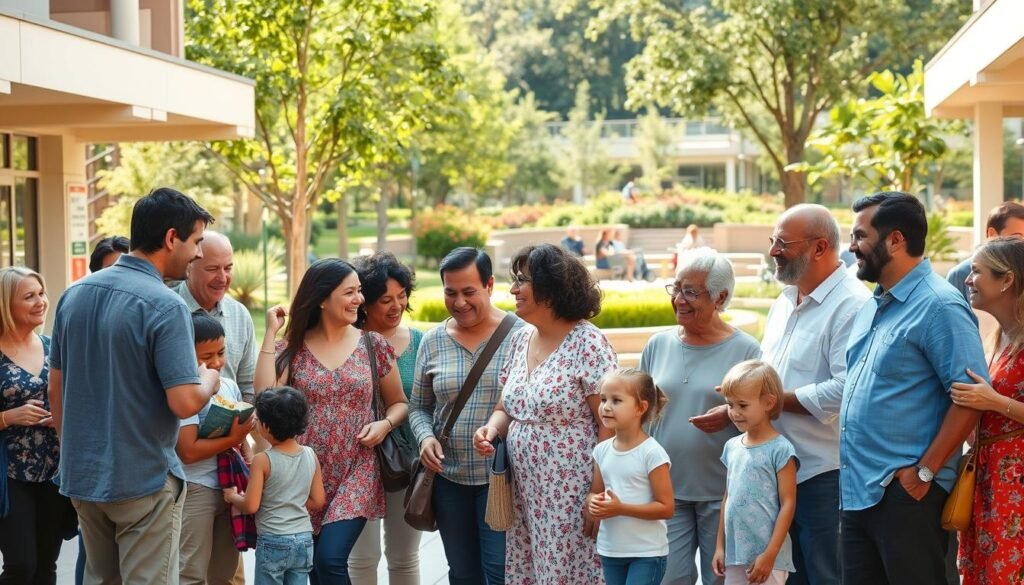What if your neighborhood could transform conflict into connection? When the FBI brought 2,000 African American employees to Clarksburg, West Virginia in 1995, a cross-burning incident shocked the town. Instead of division, this became a catalyst for change.
Today’s world moves fast. Migration and global changes create beautifully diverse populations. Every person deserves respect and equal access to resources. True communities value this diversity and respond quickly to discrimination.
Building these spaces prevents exclusion and injustice. It ensures all residents help shape decisions affecting their lives. Diversity doesn’t divide – it enriches everyone’s experience.
This guide explores practical strategies for leaders and residents. Learn how to create environments where everyone thrives together.
Key Takeaways
- Inclusive communities provide equal access to resources and opportunities for all people
- Valuing diversity strengthens community bonds and enriches life experiences
- Quick response to discriminatory incidents maintains community harmony
- Resident participation in decision-making creates stronger policies
- Collaboration between organizations and residents drives meaningful progress
- Education and understanding form the foundation of respectful relationships
- Strategic efforts can transform challenges into opportunities for community development
Understanding Inclusive Communities and Their Importance
Every neighborhood has the potential to become a place where everyone feels they belong. The journey begins with recognizing what makes a space truly welcoming for all.
What Defines an Inclusive Community
An inclusive environment shows respect for all people regardless of background. It provides equal access to resources and opportunities.
These spaces actively work to eliminate discrimination. They engage residents in decision-making processes that affect their lives.
Quick response to incidents of hate demonstrates commitment to safety. Valuing diversity becomes part of the community’s identity.
Why Building Inclusive Communities Matters
Creating welcoming spaces prevents exclusion and injustice. It ensures everyone can participate fully in community life.
Diverse perspectives lead to better problem-solving and innovation. Different backgrounds bring unique strengths that benefit everyone.
Strong relationships across groups reduce tension and conflict. People feel safer and more connected when they know they belong.
When to Begin Your Inclusion Efforts
You can start building a more welcoming environment at any time. Many initiatives begin after a harmful incident reveals existing problems.
The Clarksburg cross-burning shows how crisis can spark positive change. Motivation often determines what strategies work best.
Strong leader support accelerates progress significantly. Available resources and community backing shape the approach.
Proactive efforts typically gain wider support than reactive ones. Early action prevents problems before they escalate.
Successful inclusion work transforms challenges into opportunities. It builds capacity for handling future issues effectively.
Foundational Elements of Successful Inclusive Communities
Strong foundations turn good intentions into lasting results. These core principles create environments where every person feels valued and supported.
Valuing Diversity and Respecting Differences
Different backgrounds bring unique strengths to any neighborhood. Cultural, ethnic, and religious differences enrich daily life for all residents.
Appreciating these variations builds mutual understanding. It helps people see beyond surface-level characteristics.
This approach fosters stronger relationships across groups. Everyone gains new perspectives through meaningful interaction.
Ensuring Equal Access and Opportunities
Equity means removing barriers to resources and programs. All individuals deserve fair chances for education, jobs, and housing.
Economic and social opportunities must be available to everyone. This requires examining existing systems for hidden obstacles.
Leaders should focus on creating level playing fields. Equal access allows all members to contribute their full potential.
Eliminating Discrimination in All Forms
Justice demands fair treatment according to established standards. Proactive measures prevent racist incidents and other discrimination.
Quick response to problems shows commitment to safety. Institutions must address issues before they escalate.
Local governments, schools, and media play crucial roles. Their support or opposition significantly impacts progress.
These elements work together to create welcoming spaces. Combined implementation builds capacity for handling future challenges.
Assessing Your Community’s Current State
Before creating meaningful change, you need a clear picture of where things stand today. This assessment helps identify both strengths and areas needing improvement.
Gathering Comprehensive Community Information
Start by collecting data from multiple sources. Contact local government agencies and planning groups for official records.
Check Census Bureau data and city websites for demographic information. The National Neighborhood Indicators Project offers valuable insights.
Read local newspapers to understand current issues. Direct observation provides real-time context about daily life.
Identifying Major Groups and Their Histories
Map out the different groups living in your area. Note how long each group has resided there.
Study migration patterns and population changes. Document shifts in political, economic, and social status over time.
This historical context explains current relationships. It reveals how past events shape present dynamics.
Understanding Social Organization and Power Dynamics
Identify key gathering spots where people connect. These social hubs reveal much about community life.
Map support networks and major institutions. Note which organizations hold influence and decision-making power.
Analyze how resources and opportunities are distributed. This shows whether all members have equal access.
Pay attention to major events like elections or business changes. These moments often reveal underlying tensions or strengths.
Work directly with community representatives to ensure fair input. Conduct equal numbers of interviews across all major groups.
Surveys can identify trusted leaders and concerns. Attend local events to observe interactions and values firsthand.
This thorough assessment reveals assets, needs, and entry points for effective strategies. It creates the foundation for tailored development efforts.
Implementation Strategies for Building Inclusive Communities
Effective implementation bridges the gap between community assessment and tangible results. Moving from analysis to action requires carefully planned approaches that address specific needs.
Establishing Community Councils and Leadership Engagement
Forming a diverse council provides essential guidance for development efforts. Include influential leaders from different backgrounds to ensure balanced perspectives.
This council analyzes gathered information and identifies priority areas. They help create strategies that address the most pressing concerns.
All groups should receive equal treatment in processes and procedures. Language differences require special attention to ensure full participation.
Creating Opportunities for Cross-Group Connection
Social events and shared meals build relationships across different backgrounds. These activities celebrate diversity while creating better quality of life for everyone.
Discussions focused on common interests help people connect meaningfully. Asset exchange among groups can counteract stereotypes effectively.
Such interactions build pride in individual identity while fostering mutual respect. They create spaces where people naturally form connections.
Transforming Conflict into Community Capacity
Constructive approaches turn disagreements into growth opportunities. Outside facilitators often help navigate difficult conversations successfully.
Different cultural styles of conflict resolution deserve acknowledgment and respect. This understanding prevents misunderstandings during tense situations.
The Albuquerque Project Change demonstrates this approach well. They partnered with financial institutions to address unfair lending practices through anti-racism training.
Securing Institutional Support and Policy Changes
Engaging institutional leaders is crucial for lasting change. Make presentations that demonstrate clear benefits to their organizations.
Local governments, schools, and faith groups can drive significant progress. The South Orange/Maplewood Coalition worked with these institutions to ensure equity.
Education about structural factors like institutionalized racism creates understanding. Policy changes then support sustainable development efforts.
Strategies should prioritize concerns based on impact and feasibility. Past surveys help determine which approaches will work best.
Inclusive Housing: A Model for Community Integration
The physical spaces we inhabit daily shape our relationships and sense of belonging. Well-designed housing developments serve as powerful catalysts for social integration and connection.
This approach brings together individuals with and without disabilities in shared living environments. It creates natural opportunities for relationship building across different backgrounds.
The Three Pillars of Truly Inclusive Housing
Successful integration rests on three fundamental principles. Affordable rental options must accommodate various income levels, including those on SSI.
Universal design ensures physical and sensory access for all people. This approach benefits residents regardless of age, size, or ability.
Supportive management practices prioritize inclusion through programming and shared values. The Kelsey’s Inclusion Concierge model demonstrates effective support strategies.
Financial Benefits and Partnership Opportunities
Diverse funding sources create stronger financial stability for housing development. Multiple revenue streams enhance operational sustainability.
Collaboration between disability housing, affordable housing, and market-rate developers yields significant benefits. These partnerships leverage different expertise and resources.
Policy alignment with measures like the Olmstead Act strengthens community support. It also opens additional funding opportunities for projects.
Universal Design and Supportive Community Practices
Universal design principles ensure spaces work for everyone. Features include zero-step entries, wide doorways, and accessible controls.
Consultation with people with disabilities during design phases identifies crucial needs. This input creates truly functional spaces for all residents.
Shared amenities and common areas encourage natural interaction. Management commitment to inclusion programming fosters genuine connections.
A complete checklist should address affordability, accessibility, and supportiveness. Each element contributes to successful integration and relationship building.
Conclusion: Sustaining Inclusive Community Efforts
Building welcoming spaces requires ongoing dedication beyond initial efforts. This work continues at individual, group, and institutional levels.
Create frequent contact opportunities through established programs. Task forces can monitor progress and ensure accountability.
Support leaders who champion equity to influence policy. Celebrate successes to strengthen relationships and collaboration.
Progress may include setbacks, but sustained minor changes build long-term capacity. Comprehensive strategies transform attitudes, behaviors, and policies.
This work demands patience and courage. Collective action creates environments where all people thrive together.
FAQ
What is an inclusive community?
An inclusive community is a place where all people feel valued and respected. It offers equal access to resources and opportunities. Everyone can participate fully, regardless of background or ability.
Why is building an inclusive community important?
Building such environments strengthens social bonds and improves quality of life. It promotes fairness, reduces discrimination, and supports better health and economic outcomes for all residents.
How can a community assess its current level of inclusion?
Communities can gather data through surveys, public forums, and interviews. Understanding local demographics, history, and power structures helps identify gaps in access and participation.
What are some effective strategies for fostering inclusion?
Key approaches include forming diverse leadership groups, creating events that connect people across differences, addressing conflicts constructively, and advocating for supportive policies and institutional changes.
What role does housing play in inclusive community development?
Housing is a foundation for integration. Truly inclusive housing offers affordability, accessibility through universal design, and supportive services that help residents from all backgrounds thrive together.
How can organizations and agencies support these efforts?
Organizations can provide funding, training, and policy advocacy. They can also facilitate partnerships and share best practices to help local initiatives succeed and grow.







